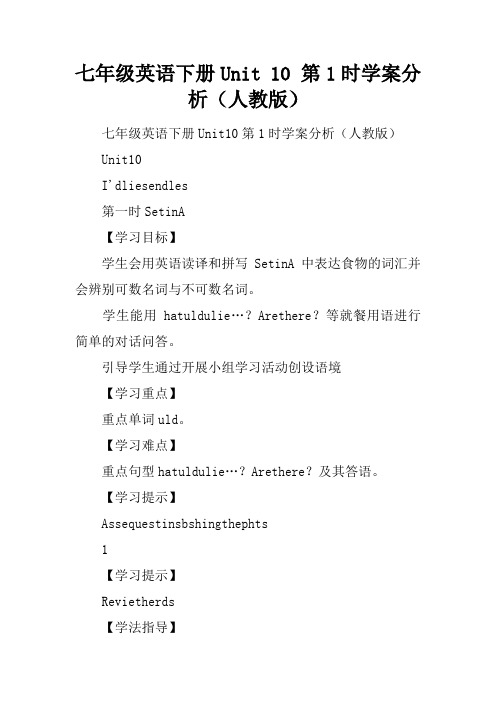七年级英语下册Unit 10 第2课时学案分析(人教版)
- 格式:docx
- 大小:59.11 KB
- 文档页数:8

新目标七下Unit 10Section B 写作学法导学案学习目标:1.巩固菜名及名词量的表达。
2.运用看图组句、1+1扩写和仿写策略为餐馆写广告词。
3.用暖心服务传递爱。
鼓励人们多与家人聚餐。
课前自学Question:What makes a good restaurant?Rank (排列)the attractions below [1-6](1is the most important).什么会成就一个好的餐馆呢?下列是吸引(顾客)的一些因素。
请用数字1-6排列(1为最重要的吸引力)。
__________a.Slogan (标语)__________b.Sanitation (卫生)__________c.Service &Sales (服务与促销)__________d.Price__________e.Dishes__________课中导学一、Find the similarities (相似点)of the slogans and try to write a slogan for Mothers’Taste .请为“妈妈的味道”餐馆写标语____________________________________________________________________________________________________________________________________________________________________________________________________________________________________________________________attractions 吸引力二、Chose a picture that you think is the most attractive to customers,write down1-2sentences by yourself._______________________________________________________________________________ _______________________________________________________________________________ _______________________________________________________________________________三、Listen to the conversation and finish a menu.四、Introduce the specials according to the menu.1.看图组句_______________________________________________________________________________ _______________________________________________________________________________ _______________________________________________________________________________ _______________________________________________________________________________ 2.1+1写错策略练习We also have some drinks,like juice and milk.A glass of juice is20dollars._________________. The milk is only for20dollars._______________________________.After dinner,would you like some desserts?The chocolate is only for8dollars each.____________________________. Two pieces of bread are only5dollars.___________________________________.五、限时写作:15分钟写作:假如你是李华,要为新开业的“妈妈的味道”餐馆写一则英文广告,80词左右内容要求:1.简单介绍餐馆。

七年级英语下册Unit 10 第1时学案分析(人教版)七年级英语下册Unit10第1时学案分析(人教版)Unit10I'dliesendles第一时SetinA【学习目标】学生会用英语读译和拼写SetinA中表达食物的词汇并会辨别可数名词与不可数名词。
学生能用hatuldulie…?Arethere?等就餐用语进行简单的对话问答。
引导学生通过开展小组学习活动创设语境【学习重点】重点单词uld。
【学习难点】重点句型hatuldulie…?Arethere?及其答语。
【学习提示】Assequestinsbshingthephts1【学习提示】Revietherds【学法指导】uldlie可构成以下词组:auldliesth意为“想要某物”。
buldlietdsth意为“想要做某事”。
.uldliesbtdsth意为“想要某人做某事”。
2【学习提示】Listenandrepeat1b2.TurntP6,listentthetapeandfinish2aand2b【学法指导】bl是名词“碗”表示“一碗……”后常接不可数名词。
【拓展】我们常用以下结构:“冠词/数词+容器名词++不可数名词”来表示不可数名词的量。
常见的有:一杯茶一杯水情景导入生成问题.Questin:hatduhavefrlunh?:___________________________________________________ _____________________2Questin:ulduliesendles?:________________________________________________________________________自学互研生成能力Tas1 Let'sreadnerdsandphrasesIanread2.Ianrite试读1a的词并翻译:愿意ld 面条羊肉牛肉洋白菜bbage土豆特色菜;特别的还;仍然大号的;大的rge点菜;命令大小;尺码两碗豆腐3.Iansuarize上面及1a中这些表示食物的名词可以分为两类:不可数名词没有任uttn,hien,beef,tfu,rie可数名词复数后面加了-s或-es。

七年级下U N I T10a n d U N I T12复习学案泰安第十五中学教师寄语:Littlebylittleandbitbybit.一点一滴,造就恒心。
复习目标:1、掌握这两个单元中重要的词汇与句型。
2、会用过去时的句子描述过去发生的事。
3、能讨论在学校中的不同规则。
一、[自主学习,基础回顾](一)Words、phrasesandsentences1、美味的2、昂贵的3、决定4、其他的5、大声地6、make的过去式7、打架8、讨论阅读P59/60/61,完成下列对话9、A:Where______you_____(go)___________(度假)B:I____________(去参加夏令营了)。
________________(你呢)A:I_______________________(参观博物馆了)B:____________________________(博物馆怎么样啊)A:It_______________(很有趣)10、-----Where_____Tina________(去哪里度假)-------She__________(呆在家里)and______________________(为考试作准备)11、-------_______you________(你去看电影来吗)lastweenend-------No,(去看我叔叔了)12、阅读短文P63,填空_____Monday,itwas_____and______(晴热)(去了一个漂亮的海滩)。
We_____________________(玩得很开心),we___________(去购物).Theshops_____(be)too_____(拥挤),soI_______(notenjoy),it_______(rain).sowewenttoa_________(博物馆)。
(find)asmallboy_________(cry)inthe_______(角落).He______(迷路了)andIhelpedhim_______(find)(make)____(i)_____(feel)’t______(have)_____(some)累)。

Unit10 I'dlikesomenoodles.
1.本单元话题以“食物”展开,情境属于新课标“人与社会”主题范畴中的“历史、社会与文化”这一主题群,涉及子主题“跨文化沟通与交流,语言与文化”。
2.单元主题体现《中国学生发展核心素养》中的“文化基础”方面,提升学生的“人文底蕴”这一素养,立足于“人文情怀”这一基本要点。
3.能识记有关食品的词汇;能正确识别可数名词与不可数名词;能熟练运用“Whatkindofnoodlesdoyouhave ?”“Whatsizewouldyoulike?”等句子询问他人对食物的要求。
4.通过听听力材料,获取与食物相关的信息。
5.能运用wouldlike 进行写作。
6.在交流中学会热情好客,礼貌地表达自己的需要。
续表
【课时建议】本单元建议5课时
SectionA(1a-1c)(一课时)
SectionA(2a-2d)(一课时)
SectionA(GrammarFocus-3c)(一课时)
SectionB(1a-1d)(一课时)
SectionB(2a-SelfCheck)(一课时)
词汇短语:主要采用图片及多媒体展示助记忆法。
基本句子:采用多媒体展示及交际法(利用多媒体展示两人进行交际时的情景)。
语法:学会如何点餐。

七年级英语下册Unit 10 第4课时学案分析(人教版)七年级英语下册Unit 10 第4课时学案分析(人教版)第四课时 B (2a~2c)【学习目标】1学生会用英语读译和拼写重点单词:answer。
2指导学生通过阅读能够准确理解并运用重点短语掌握the number of…/a number of…的区别。
3引导学生通过开展小组讨论活动了解各地人们过生日时所吃的食物以及所代表的意义丰富自己的文化知识。
【学习重点】正确运用重点单词、短语和句子掌握the number of…/a number of…的用法。
【学习难点】能够运用所学知识熟练复述不同国家过生日的不同方法。
【学习提示】Lead in a new topic by asking and answering some qu【学习提示】Review the wordxt and2a.【学法指导】The number of candl's age.蜡烛的数量是这个人的年龄。
【用法】the number of表示“……的数量”跟复数名词连用作主语时中心词是number谓语动词要用单数。
2【学习提示】1Fast reading.(1)Ss readquicklw the main idea andasks in 2b.(2)anslate the difficul2.Intensive readingudents read the passage carefully,answer the qu2b,finish and mark the answx.Retellingudut the maassage andll them.情景导入生成问题1.(T)Question:What do you do on your birthday?:_________________________________________________ _______________________2(T)Question:What do you eat on your birthday?:_________________________________________________ _______________________自学互研生成能力Task 1 Let's read new words and phraI canread.(我会读)2.I can write.(我会写)阅见所赠光盘3.I can summarize.(我会总结)句型的用法见所赠光盘见所赠光盘Task 2 Let's read 2b and gain ideaassagFast reading.(快速阅读)快速阅读2b完成2b中的任务。

UNIT 10 I’d like some noodles.Section A 第1课时(1a〜1c)自主学习方案1.自学生词,并记住拼读及拼写。
2.预习课本找出重点短语及句子。
(见学案自学导练内容)3.读记后完成自学导练内容。
课堂导学方案Step1 情景导入Everyone has his own taste. So what kind of food do you like?What’s your favorite food?Do you like noodles?What kind of noodles do you like?Today we'l talk about the kinds of noodles.环节说明:就学生感兴趣的身边的话题导入新课,简洁明了,引人入胜。
Step 2完成教材1a—1c的任务1.学生认真观察1a图片中的食物,然后将词语与图片搭配,集体核对答案。
(2分钟)2,老师领读单词,并纠正发音。
(2分钟)3.学生认真听录音,标出顾客所点的面条,集体核对答案,完成课本上1b的听力任务。
(3分钟)4.两人一组练习1a中的对话,然后编新对话进行练习,并请一些学生表演出他们的对话。
(5分钟)参考案例:A:What would you like?B: I,m not sure yet. Are there any vegetables in the mutton noodles?A: Yes,there are some cabbages.B: OK,I’d like the mutton noodles.5.小结训练。
(2分钟)(1)一Would you like some beef?— C .A. Yes,I wouldB. No,I wouldn’tC.Yes, pleaseD. Thanks(2)There are B hamburgers in our restrant. Would you like ?A.some;someB. some;anyC.any; anyD. any;some环节说明:听说结合,第一时间向学生传达语言目标,通过结对对话练习和小结训练,使语言目标得以强化。
七年级英语下册Unit 10 第3时学案分析(人教版)七年级英语下册Unit10第3时学案分析(人教版)第三时SetinB【学习目标】学会读译、拼写本时单词正确区分食物的可数名词与不可数名词。
2学生会用英语订餐学会打电话订餐并表达自己的喜好。
3引导学生通过听说【学习重点】重点单词dupling。
【学习难点】创设不同的场景学会打电话订餐并表达自己喜欢的食物。
【学习提示】Assequestinsbshingthepitures1【学习提示】Revietherds【学法指导】Idn'tlienins我不喜欢洋葱、绿茶和稀饭。
【用法】r意为“或者还是”通常用在否定句和疑问句中连接并列的词或句子。
2【学习提示】Finish1a,1bingrups2.Fllthetape,finish1,1d,thenlistenagain3.AsseSstshtheansers【学法指导】large与big的用法区别:与big都可表示具体事物面积和体积的大小通常可以互换多用于口语中。
【举例】Thereisabig/largeplagrundinurshl在我们学校里有一个大操场。
情景导入生成问题.Questin:Dulieduplings?:___________________________________________________ _____________________2Questin:DesLulieprridge?:___________________________________________________ _____________________自学互研生成能力Tas1 Let'sreadnerdsandphrasesIanread2.Ianrite试读1a的词并翻译下列单词和短语。
饺子粥;面糊洋葱鱼肉烙饼绿茶橙汁3.Ianpratie根据1b要求用下列句型练习对自己和他人喜欢和不喜欢的食物进行询问及陈述。
⼈教版初中七年级英语下册第⼗单元Unit10教案含教学反思第10单元I’d like some noodles.类别课程标准要求掌握的内容话题Food⾷物Section A 单词noodle n.⾯条beef n.⽜⾁potato n.⼟⾖;马铃薯would modal v.(表⽰意愿)愿意yet adv.还;仍然large adj.⼤号的;⼤的order n.& v.点菜;命令size n.⼤⼩;尺码bowl n.碗meat n.(可⾷⽤的)⾁special n.特⾊菜;特价品adj.特别的;特殊的cabbage n.卷⼼菜;洋⽩菜mutton n.⽺⾁tofu n.⾖腐短语would like愿意;喜欢take one’s order 点菜what size多⼤(尺⼨)one (large)bowl of…⼀(⼤)碗……what kind of哪⼀种……句型1.—What would you like? 您想要点什么?—I’d like some noodles. 我想要些⾯条。
2. Are there any vegetables in the beef noodles?⽜⾁⾯⾥有蔬菜吗?3. We’d also like gongbao chicken and some mapo tofu with rice.句型1. The number of candles is the person’s age.蜡烛的数量是过⽣⽇的⼈的年龄。
2. If he or she blows out all the candles in one go,the wish will come true. 如果他/她⼀⼝⽓吹灭所有的蜡烛,许的愿望便会成真。
3. They never cut up the noodles because the long noodles are a symbol of long life. 他们从不切碎⾯条,因为长长的⾯条是长寿的象征。
Unit 2 What time do you go to school?第一课时(Section A 1a-1c)【学习目标】1. 学习谈论自己和他人的日常生活和作息习惯,并能合理安排自己的作息时间。
2. 会用what time 引导的特殊疑问句来询问做某事的时间。
【学习重点】★重点单词:up(向上), dress(穿衣服;连衣裙), brush(刷;刷子), tooth(牙齿), shower (淋浴;淋浴器), usually(通常地;一般地), forty(四十).★重点短语:get up(起床;站起), get dressed(穿上衣服), take a shower(洗淋浴).★重点句型:— What time do you usually take a shower, Rick?(你通常几点洗澡,里克?)— I usually take a shower at six forty.(我通常六点四十洗澡。
)【课前预习方案】(一)小小翻译官。
(请预习课文,将下列中文译成英文)1. 起床get up2. 去上学go to school3. 穿衣服get dressed4. 刷牙brush teeth5. 吃早餐eat breakfast6. 洗澡take a shower7. 什么时候;几点what time 8. 六点四十six forty(二)请朗读1a有关日常活动的短语,并将其与对应的图片相匹配。
(三)请试着将下列时间用英语写出来。
1. 6:00 six o'clock2. 6:10six ten3. 6:15 six fifteen4. 6:20 six twenty5. 6:30six thirty6. 6:40six forty7. 6:50six fifty 8. 7:00seven o'clock9. 7:15seven fifteen 10. 7:20seven twenty11. 7:30seven thirty 12. 7:45seven forty-five(四)想一想。
Unit 10 I’d like some noodles.Section A (Grammar Focus-3c)一、教学目标1. 能掌握以下词汇:meat2. 能分辨并能正确使用可数名词和不可数名词。
Countable nouns: bowls, dumplings, apples, strawberries, oranges, carrotsUncountable nouns: beef, meat, milk, mutton, waterCountable and uncountable nouns: chicken, salad, ice-cream, cabbage, onion3.掌握下列句型:(1)—What kind of noodles would you like? —I’d like beef noodles, please.(2)—What size would you like? —I’d like large bowl, please.(3)—Would you like a large bowl? —Yes, please.(4)—Is there any meat in the tomato and egg soup? —No, there isn’t any./No, there’s no meat.4.掌握不定代词some和any的用法。
5.引导学生通过分类整理,归纳出肯定句、一般疑问句和特殊疑问句的结构特点。
6.通过开放式的小组活动,让学生谈论自己的饮食喜好,提供真实的情景,培养学生的小组合作能力和口语表达能力。
二、教学重点及难点重点:1.会运用所学的知识将含有would like的句子进行分类整理,并归纳出不同句式的结构特点。
2.会运用所学知识归纳some/any的用法。
难点:能分辨英语中名词的可数和不可数及其组成规律。
三、教学准备教师:教学课件;多媒体设备学生:课前预习四、教学过程Step 1. Warming-upSs look at the picture and talk about the food they’d like in their group, then report it.T: Hello, everyone! Let’s begin our class. Look at the picture and talk about the food you’d like inyour group.…T: Now try to report the food the members would like in your group.…T: Any volunteers? Come to the front to show us your report.【设计意图】通过口语练习,帮助学生们复习巩固上节课学的词汇和句型。
七年级英语下册Unit 10 第2时学案分
析(人教版)
七年级英语下册Unit10第2时学案分析(人教版)
第二时SetinA
【学习目标】
学生能用uldlie来表达自己想要的食物并正确使用不可数名词。
2通过小组练习学生能流利使用hatindfndlesuldulie?hatsizeuldulie?ulduliealargebl?等就餐用语进行对话。
3通过学习西方饮食文化使学生体会中西饮食方式与文化的不同正确使用就餐用语。
【学习重点】
会使用就餐用语进行情景对话了解中西饮食文化。
【学习难点】
句型uldulie…?
hatindf…?hat
【学习提示】
GreetSs
2.Revietheesentenepatternsbasingandanseringsequest ins
Tas1
【学习提示】
Revietherds,phrasesandsentenesnP7Studentsarthenerdsandhineseean inginthetext
2.SsreadtheGraarFusbtheselvesPaattentintthesentene patterns
【学法指导】
hatind意为“何种;哪种”是名词意为“种类”可构成词组:aindf一种各种各样的这种……那种……不同种类的。
Tas2
【学习提示】
ReadthedialguesnP7Thenpratieithurpartner
【学法指导】
uldlie是表示意愿的用语意为“想要”相当于ant。
uldliesth意为“想要某物”。
【举例】I'dliesehaburgers我想要些汉堡。
意为“想做某事”。
相当于anttdsth。
【举例】He'dlietgtshlnft他想步行去上学。
情景导入生成问题
.Questin:hatindfndlesuldulie?
:___________________________________________________ _____________________
2Questin:hatsizeuldu
lie?
:___________________________________________________ _____________________
自学互研生成能力
Tas1 Let'sreadnerdsandphrases
Ianread
2.Ianrite
西红柿鸡蛋面
胡萝卜羊肉面
两碗饭
一大碗羊肉汤
宫保鸡丁盖饭
一些麻婆豆腐
3Iansuarize
认真观察上面的两种面有什么不同。
西红柿鸡蛋面eggndlesithtates也可说成。
胡萝卜羊肉面arrtanduttnndles也可说成ts。
用来修饰名词“面条”的名词放在前面要用单数如asheshp;放在“面条”后面的可数名词用复数并用连接翻译成“带有;具有”。
如:ndlesitheggs翻译成:带鸡蛋的面条。
不可数名词要借助“数词+f+不可数名词”来表示不可数名词
的量如:一大碗羊肉汤
八中碗大米ediu__bls__f__rie
见所赠光盘
Tas2 Let'saenversatins
Iantranslate
见所赠光盘
2Ianpratie
完成教材3a和3b部分的练习。
3Ianaenversatins
小组合作分别扮演服务员和客人编写对话。
_________________________________________________
___________________________________________________ _____________________
uldliesbtdsth意为“想要某人做某事”。
【举例】The'dliethebtstahere他们想让这个男孩待在这里。
?疑问句的回答为:es?疑问句的回答为:es
Tas3
【学习提示】
Finish3a
【学法指导】
可数名词和不可数名词
不可数名词所表示的事物不能用数来计算不和具体数词连用没有复数形式。
如:il等。
2抽象名词和物质名词一般是不可数名词。
如:nes等。
3不可数名词不和a/an连用不可数名词需要计量时要加表示数量单位的词。
如:apieefpaper等。
类别
单词
可数
名词
不可数
名词
fish
鱼
鱼肉
小鸡
鸡肉
论文
纸
玻璃杯
玻璃
【备注】
资*源%库
4Iansuarize
就餐或购物时服务员常说:aI
anI__help__u?
如果需要用es如果不需要用N
询问别人想要什么食物:
其答语为:I'd
lie…
询问别人想要什么型号尺码大小:…uldulie?
其答语为:I'dliea
见所赠光盘
Tas3 aeasurve
调查组内同学的饮食爱好并完成3然后两人一组做pairr练习对调查结果互相提问如:hatuldulieteat?I'dliebeefndlesitharrts
见所赠光盘
交流展示生成新知
Presh:Shingrups
Tas1:First
Tas2:FirstartherngrdsAtlast,shthednntheblabard
Tas3:First,thestudentsreadGraarFustiebtheselvesThenthetrtreite GraarFusingrups
Prtinsh:lasssh
Tas1:1IanreadReadtgether;
nslidatetherdlearningbrdgaes
2IanriteFinishtheexerisesintas;Readtgether
3Iansuarize
Tas2:1IanpratieAsstudentstfinishtheexerises;hetheansersbanseringquilandexplain;Readingrups
2IanritePuttherdsinrdertaenversatins;Setthesenestperfrthenversatins;Spttest
Tas3:aeareprtthenperfr
当堂演练达成目标
见所赠光盘
后反思查漏补缺
收获:___________________________________________________ _____________________
存在困惑:___________________________________________________ _____________________。